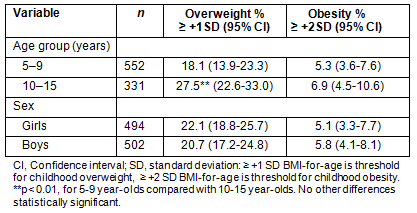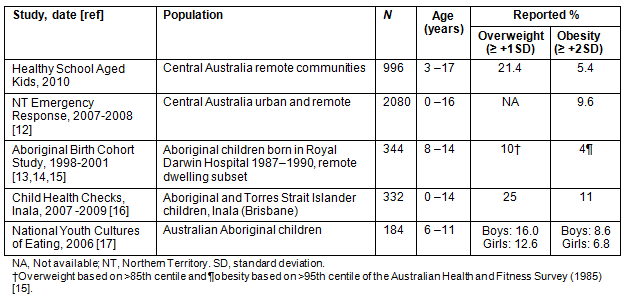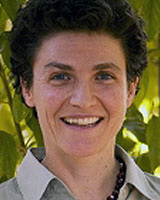High prevalences of chronic diseases at young ages in remote Northern Territory (NT) Aboriginal populations have been documented. For example, by 15 years of age 8.6% have renal disease, 0.4% have type 2 diabetes and 0.3% have ischaemic heart disease1. Compared with all Australians the overall burden of disease suffered by the Aboriginal people of NT is close to four times higher; much of this excess is due to ischaemic heart disease, renal disease and diabetes, for which overweight and obesity are important risk factors2. This report contributes to the limited published data on population prevalence of overweight and obesity in Aboriginal children, with community based data on children in remote communities in central Australia.
Remote Aboriginal communities in NT have populations of from less than 50 to more than 1000 people, and over 90% of people in these communities are Aboriginal3. These communities are classified by Australian Remoteness Index for Areas (ARIA+) as Very Remote, indicating the highest levels of remoteness from service centres3-5. The populations of these communities are growing, leading to increasing levels of overcrowding and limited educational and employment opportunities3,6. However approximately two-thirds of Aboriginal people in NT live in these communities rather than move to urban centres, and this proportion is not declining7.
In this report, 'central Australia' consists of Alice Springs and Barkly districts of NT, where 20 000 or 31.3% of the NT Aboriginal people live3.
The Healthy School-Aged Kids Program is a joint initiative of the NT Departments of Health and Education, run throughout remote Aboriginal communities in NT. It is a population health program involving health promotion, service integration and health checks. An evaluation was performed in 1998, leading to a revision of the manual published in 20078,9. The manual provides detailed guidelines for child health and remote area nurses and Aboriginal health workers, including health checks to identify and manage common health problems in children aged 5-15 years. The recommended checks include height and weight of children aged 5, 10 and 15 years9.
The poor health and socioeconomic status of NT Aboriginal children is of national concern, and led to the NT Emergency Response (NTER). The 2007-2008 phase of the NTER involved visiting teams offering health checks to all children aged up to 16 years10. Implementation of the Healthy School-Aged Kids Program was variable during the NTER but returned to the standard program in 2010. This report describes the prevalence of overweight and obesity among children in central Australia who underwent health checks in Healthy School-Aged Kids Program in 2010.
The Healthy School-Aged Kids Program entails engagement of health staff and community Elders, teachers and parents of children in remote communities. Health checks are offered to every child aged 5-15 years. Parents or guardians are asked to give written consent for their children to be checked. Children not at school are encouraged to participate9.
Participating children are measured by nurses and Aboriginal health workers using stadiometers and digital scales. The guidelines include measuring and weighing children at 5,10 and 15 years9. Weight is measured to 0.1 kg, and height to the nearest centimetre. Equipment is calibrated monthly11. For this report, the children's date of birth, sex, height and weight were entered into WHO AnthroPlus application (http://www.who.int/growthref/tools/en/) to calculate BMI and BMI-for-age z-scores based on WHO 2007 growth standards. The significance of the difference between proportions was calculated using two-tailed z-tests for independent proportions, utilising the VassarStats (http://faculty.vassar.edu/lowry/VassarStats.html) statistical calculator.
The program ran between March and October 2010. Participating children's ages ranged from 3 to 17 years, although guidelines recommend measuring weight and height only at 5, 10 and 15 years9.
The BMI-for-age data were available for 996 children in 26 communities, with between 4 and 109 children measured in each community. This included 883 in the target population of 1764 children aged 5 to 15 years, giving 50% coverage among these children. It was found that 21.4% of children were overweight (≥+1.0 standard deviation [SD] BMI-for-age; 95% CI 18.6-24.5%) and 5.4% were obese (≥+2.0 SD BMI-for-age; 95% CI 4.2-7.0%). No community had BMI-for-age distribution significantly different from the overall distribution.
The BMI-for-age according to age groups and sex is shown (Table 1). Overweight increased with age (z=3.28, p=0.0011), while obesity did not (z=0.68; p=0.50). There was no difference in the prevalence of overweight or obesity between boys and girls (overweight z=0.52; p=0.60; for obesity z=0.50; p=0.62).
Table 1: Prevalence of overweight and obesity among children
in remote central Australia, according to age group and sex

Discussion
Health checks performed on children in remote Aboriginal communities in 2010 showed that 21.4% of children were overweight and 5.4% obese. Other cardiovascular risk factors were not assessed in the Healthy School Aged Kids Program.
Comparative data from other recent studies of prevalence of overweight and obesity among Australian Aboriginal children shows a diversity of results (Table 2). Data from the NTER defined 'overweight' as BMI-for-age >95th centile, which is consistent with other definitions of obesity. The prevalence of overweight reported in the NTER was significantly higher than the prevalence of obesity in this study12. The lower prevalence of overweight and obesity among the remote-dwelling children in the Aboriginal Birth Cohort Study is also notable because there are lower prevalences of chronic diseases among Aboriginal people in the 'Top End' (the northern region of NT) compared with central Australian Aboriginal people of NT, although different standards for overweight and obesity were used1,13-15. Alternatively a lower prevalence reported in the Aboriginal Birth Cohort Study approximately 10 years before the present study may reflect an increased prevalence of overweight and obesity over the past 10 years. The higher prevalence of obesity among the children at Inala in Brisbane may reflect differences between urban and rural populations noted in the Aboriginal Birth Cohort Study13,16.
Table 2: Reports of prevalence of overweight and obesity among Australian Aboriginal children

The 2007-2008 National Health Survey identified that 25% of children aged 5 to 17 years were overweight, including 8% obese. Data on Aboriginal children were not reported separately18.
The sample was limited to children who attended the health checks, and included children whether or not they attended school. The sample of 996 included 883 in the age range 5-15 years, of 1764 children in remote central Australia. Aboriginal status was not recorded in the health checks which are targeted at the needs of the Aboriginal children. Australian Bureau of Statistics reports that 92.4% of 5-15 year-olds in remote central Australia are Aboriginal19.
Conclusion
The high burden of chronic diseases attributable to overweight among Aboriginal people in central Australia is a devastating problem. Rates of childhood overweight and obesity described here do not reflect the four-times greater burden of disease in this population compared with all Australians2. Possible reasons for the discrepancy include BMI-for-age not adequately predicting future cardiovascular risk in this population; selective non-participation of overweight children; and increasing overweight after school age. The NHMRC Clinical practice guidelines for management of overweight and obesity in children and adolescents recommended further research to determine whether children's BMI-for-age correlates with medical morbidity, and that Aboriginal children may need separate consideration20. These Healthy School Aged Kids Program health check data results support this recommendation, and the proposition that waist circumference may be a better predictor of cardiovascular risk than BMI-for-age in this population21,22.
Attention to the underlying causes of the disease burden of Aboriginal people in remote central Australia includes measures to promote healthy eating and physical activity. A review of current Healthy School-Aged Kids Program guidelines and implementation, particularly the monitoring of waist circumference, should be considered. In the absence of standardised survey methods, conclusions about relative rates of overweight and obesity in different populations of Aboriginal and non-Aboriginal children cannot be drawn. Aboriginal children in particular are diverse populations.
Acknowledgement
The author acknowledges all who enable the Healthy School Aged Kids program in central Australia, including community Elders, teachers, child health nurses, remote area nurses, Aboriginal health workers, and all the children who participated.
References
1. Zhao Y, Connors C, Wright J, Guthridge S, Baillie S. Estimating chronic disease prevalence among the remote Aboriginal population of the Northern Territory using multiple data sources. Australian and New Zealand Journal of Public Health 2008; 32(4): 307-313.
2. Zhao Y, You J, Guthridge S. Burden of disease and injury in the Northern Territory, 1999-2003. Darwin, NT: Department of Health and Families, 2009.
3. Australian Bureau of Statistics. Chapter 4; Detailed State and Territory Tables. In: Housing and Infrastructure in Aboriginal and Torres Strait Islander Communities, Australia 2006. ABS Cat No. 4710.0. (Online) 2007. Available: http://www.abs.gov.au/AUSSTATS/abs@.nsf/Lookup/4710.0Main+Features22006?OpenDocument (Accessed 26 November 2011).
4. National Centre for Social Applications of Geographic Information Systems. About ARIA+ (Accessibility/Remoteness Index of Australia). (Online) 2011. Available: http://gisca.adelaide.edu.au/projects/category/about_aria.html (Accessed 26 November 2011).
5. Li SQ, Guthridge SL, Tursan d'Espaignet E, Paterson BA. From infancy to young adulthood: health status in the Northern Territory 2006. Darwin, NT: Department of Health and Community Services, 2007.
6. Australian Institute of Health and Welfare. The health and welfare of Australia's Aboriginal and Torres Strait Islander People, an overview 2011. Cat no. IHW 42. Canberra, ACT: AIHW, 2011.
7. Taylor J. Demography is destiny, except in the Northern Territory. In: J Altman, M Hinkson (Eds). Coercive reconciliation. Melbourne, VIC: Arena, 0000; 173-183.
8. Paterson B, Ruben A, Nossar V. School screening in remote Aboriginal communities - results of an evaluation. Australian and New Zealand Journal of Public Health 2008; 22(6): 685-689.
9. Department of Health and Community Services and Department of Employment Education and Training. Healthy school-aged kids: the Northern Territory School-Age Child Health Promotion Program Manual for remote communities, 2nd edn. Darwin, NT: Department of Health and Community Services, 2007.
10. Australian Government Department of Families, Housing, Community Services and Indigenous Affairs. Northern Territory Emergency Response. (Online) 2010. Available: http://www.fahcsia.gov.au/sa/indigenous/progserv/ntresponse/Pages/default.aspx (Accessed 9 February 2011).
11. Northern Territory Department of Health. Maintenance and repairs of clinical equipment. In: Remote Health Atlas. (Online) 2009. Available: http://remotehealthatlas.nt.gov.au/maintenance_&_repairs_clinical_equipment.pdf (Accessed 9 April 2011).
12. Australian Institute of Health and Welfare and Department of Health and Ageing. Progress of the Northern Territory Emergency Response Child Health Check Initiative: preliminary results from the Child Health Check and follow-up data collections. Cat. no. IHW 25. Canberra, ACT: AIHW; 2008.
13. Mackerras DE, Reid A, Sayers SM, Singh GR, Bucens IK, Flynn KA. Growth and morbidity in children in the Aboriginal Birth Cohort Study: the urban-remote differential. Medical Journal of Australia 2003; 178: 56-60.
14. Sayers S, Singh G, Mackerras D, Lawrance M, Gunthorpe W, Jamieson L et al. Australian Aboriginal Birth Cohort study: follow-up processes at 20 years. BMC International Health and Human Rights 2009, 9: 23.
15. Lazarus R, Baur L, Webb K et al. Recommended body mass index cutoff values for overweight screening programmes in Australian children and adolescents: comparison with North American values. Journal of Paediatrics and Child Health 1995; 31: 143-147.
16. Coleman JJ, Spurling GK, Askew DA, Hayman NE. Indigenous child health checks: the view from the city. Medical Journal of Australia 2011; 194: 535-536.
17. O'Dea J. Gender, ethnicity, culture and social class influences on childhood obesity among Australian schoolchildren: implications for treatment, prevention and community education. Health and Social Care in the Community 2008; 16(3): 282-290.
18. Australian Bureau of Statistics. 4364.0 National Health Survey: Summary of Results 2007-2008 (Re-issue). (Online) 2009. Available: http://www.abs.gov.au/AUSSTATS/abs@.nsf/mf/4364.0/ (Accessed 17 February 2011).
19. Australian Bureau of Statistics. 2068.0 Census tables 2007, Updated 27/06/2007. (Re-issue). (Online) 2009. Available:http://www.abs.gov.au/ausstats/abs@.nsf/PrimaryMainFeatures/2068.0 (Accessed 13 March 2012).
20. National Health and Medical Research Council. Clinical practice guidelines for the management of overweight and obesity in children and adolescents. Canberra, ACT: Commonwealth of Australia, 2003.
21. Wang Z, Hoy WE. Waist circumference, body mass index, hip circumference and waist-to-hip ratio as predictors of cardiovascular disease in Aboriginal people. European Journal of Clinical Nutrition 2004; 58: 888-893.
22. Sellers EAC, Singh GR, Sayers SM. Large Waist but Low Body Mass Index: the metabolic syndrome in Australian Aboriginal Children. Journal of Pediatrics 2008; 153: 222-227.

